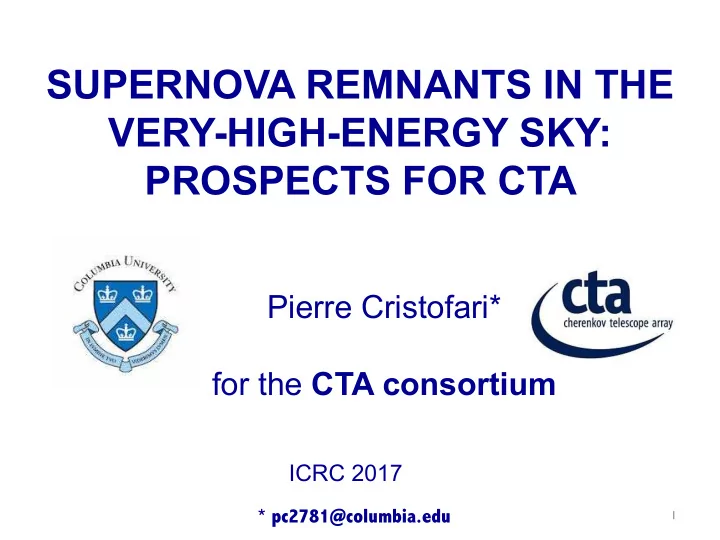

SUPERNOVA REMNANTS IN THE VERY-HIGH-ENERGY SKY: PROSPECTS FOR CTA Pierre Cristofari* for the CTA consortium ICRC 2017 * pc2781@columbia.edu 1
SNRs in the TeV sky Scott Wakely & Deirdre Horan 2 tevcat2.uchicago.edu
Gamma rays from SNRs ISM CR Hadronic interactions : p + p → p + p + π 0 Pion decay π 0 → γ + γ Leptonic interactions : � i Inverse Compton scattering � f Situation unclear for many SNRs: instead of individual study, study of the entire population Aharonian et al. (2006) Aharonian et al. (2009) Acciari et al. (2011) 3 Tycho – VERITAS RXJ 1713 - HESS RCW 86 - HESS
Cherenkov Telescope Array (CTA) CTA H.E.S.S. ≈ 1 mCrab F(>1 TeV) ≈ 0.05° ≈ 15 mCrab |l|<60° ; |b|<2° ≈ 0.1° |l|<40° ; |b|<3° ≈ 3 mCrab ≈ 0.05° All-sky survey 4
A Monte Carlo approach What we need: Model for Time and Spatial Gas density acceleration of + + distribution of distribution in cosmic rays in SNRs the Galaxy one SNR Gamma emission of one SNR Number of detectable SNRs by a given telescope 5
Time and spatial distribution of SNRs Time distribution: SN rate: 3/century Faucher-giguère, Kaspi (2006) Spatial distribution: Lorimer et al. (2004) SN progenitor types Ptuskin et al. (2010) Thermonuclear Core-collapse 6
Evolution of SNRs : type Ia ◆ 1 / 7 E 2 ✓ t 4 / 7 51 R sh = 5 . 3 kyr pc n 0 M ej , � Free expansion ◆ 1 / 7 E 2 ✓ t � 3 / 7 u sh = 3 . 0 × 10 3 51 km/s kyr n 0 M ej , � ◆ 1 / 5 ✓ M ej , � E � 1 / 2 n � 1 / 3 t � 260 yr 51 0 1 . 4 ! 2 / 5 0 . 06 M 5 / 6 ◆ 1 / 5 ✓ E 2 t 2 / 5 ej , � 51 R sh = 4 . 3 1 − pc Sedov phase kyr E 1 / 2 51 n 1 / 3 n 0 t kyr 0 ! � 3 / 5 0 . 06 M 5 / 6 ◆ 1 / 5 ✓ E 2 t � 3 / 5 ej , � 51 u sh = 1 . 7 × 10 3 1 − km/s kyr E 1 / 2 51 n 1 / 3 n 0 t kyr 0 Chevalier (1982) Truelove& Mckee (1999) Ptuskin (2005) Type II Thin Shell approximation Momentum conservation Weaver (1977) d d t ( Mu sh ) = 4 π R 2 sh P in Energy conservation 4 π sh + 1 3( γ + 1) P in R 3 2 Mu 2 E = Wind with R -2 ISM Hot and tenuous 7 density profile bubble Ostriker & Mckee (1988)
Gas distribution We are here We extrapolate using fits from Shibata et al. (2010) HI H 2 Nakanishi&Sofue (2006) Nakanishi&Sofue (2003) 8
Particle acceleration 1. Efficiency : P 0 CR = ξ CR ρ up u 2 ξ CR = η CR ≈ 0 . 1 sh acceleration TIME INTEGRATED INSTANTANEOUS efficiency at the Supported by theoretical work Caprioli (2010), shock Ptuskin & Zirakashvili (2008) 2. Slope of accelerated particles: free parameter N CR ∝ p − α α = 4 . 1 ... 4 . 4 3. Maximum energy of accelerated protons D ( E max ) diffusion ≈ 0 . 05 ... 0 . 1 R sh length u sh Loss-limited ( u sh /v d ) 2 + 1 p B down = σ B 0 X-ray filaments : fraction of kinetic energy into magnetic field 9
Particle acceleration: electrons N e N p ∝ E − α electron-to-proton K ep = 10 − 5 ... 10 − 2 K ep ratio ∝ E − α − 1 ∝ E − α E e E e break max Longair (1990) ◆ ✓ B down ◆ − 1 / 2 acc rate= synch loss rate ✓ u sh E e max ≈ 7 . 3 TeV 1000km/s 100 µ G t synch =t age E e Vannoni et al. 2009 break 10
Number of detections by CTA ≈ 400 SNRs ≈30 SNRs Above the most optimistic scenario with H.E.S.S 11 Cristofari et al. 2017
Number of detections by CTA α=4.1 K ep =10 -2 ≈ 500 SNRs ≈ 350 SNRs ≈ 180 SNRs 12 Cristofari et al. (2017)
Number of detections by CTA F(>1 TeV) F(>10 TeV) Cristofari et al. 2017 13
Conclusions and future perspectives • A new test for the SNR hypothesis • Constraining parameters governing particle acceleration • Estimation on the SNR population accessible by CTA: – Improvement compared to H.E.S.S – Caracterization of the population • Detection ≈ 22 - 120 SNRs • Size ≈ 0.2° • Distance ≈ 7-10 kpc • Ages ≈ 4-6 kyr • Results of our approach confronted with other instruments (HAWC, HiSCORE) • Detections of neutrinos from SNRs, search of PeVatrons 14
Recommend
More recommend